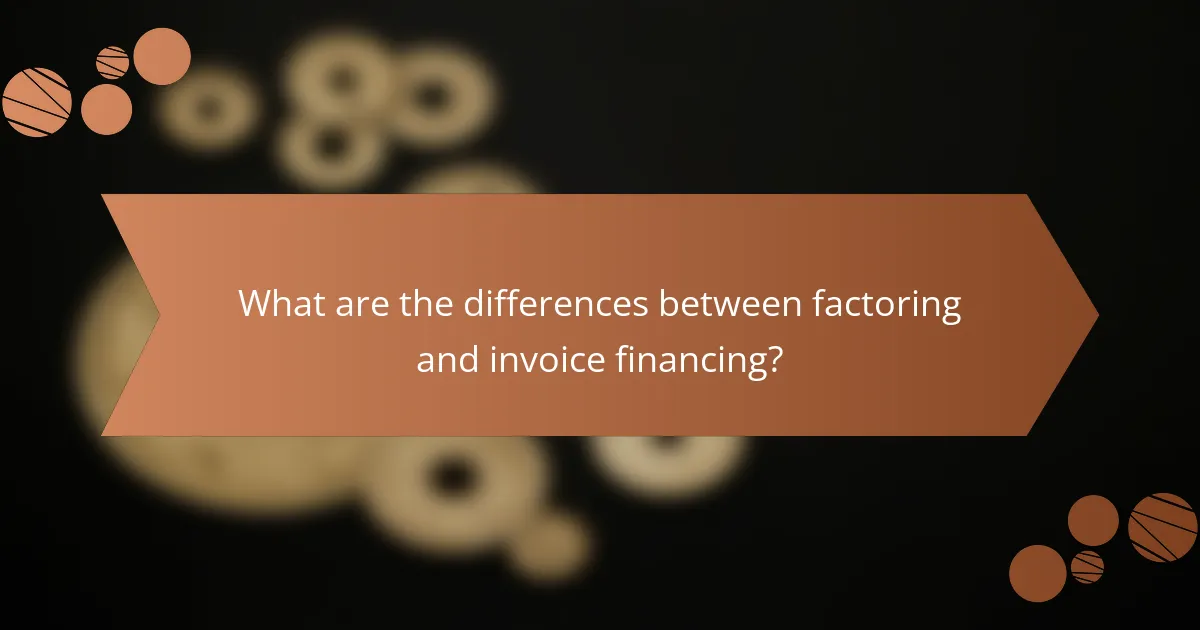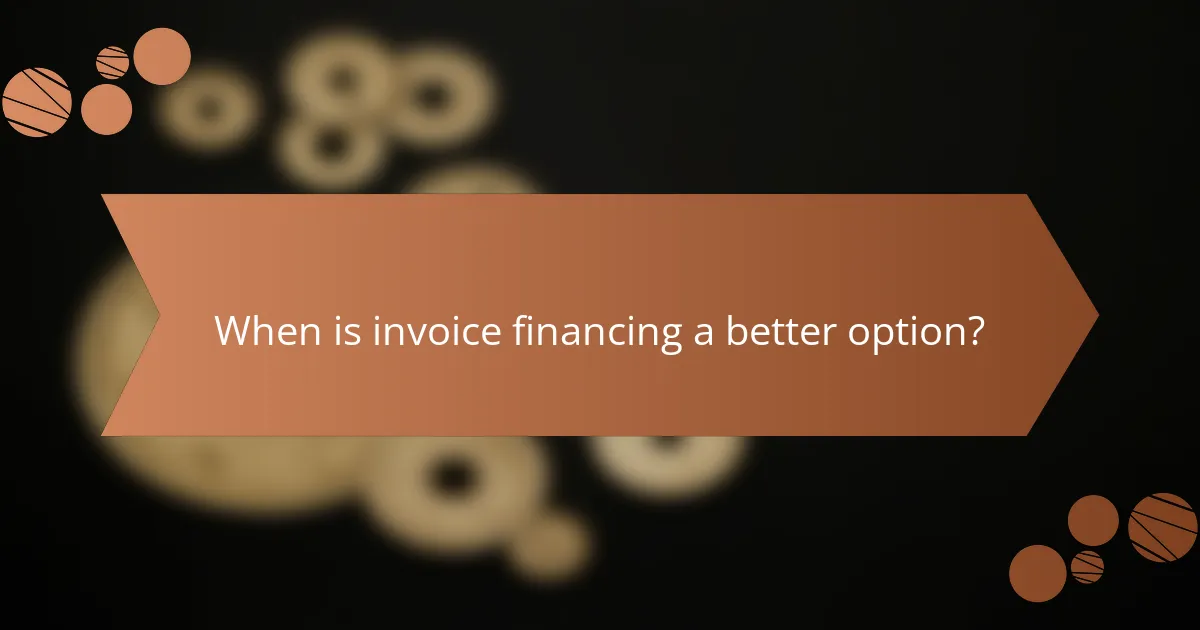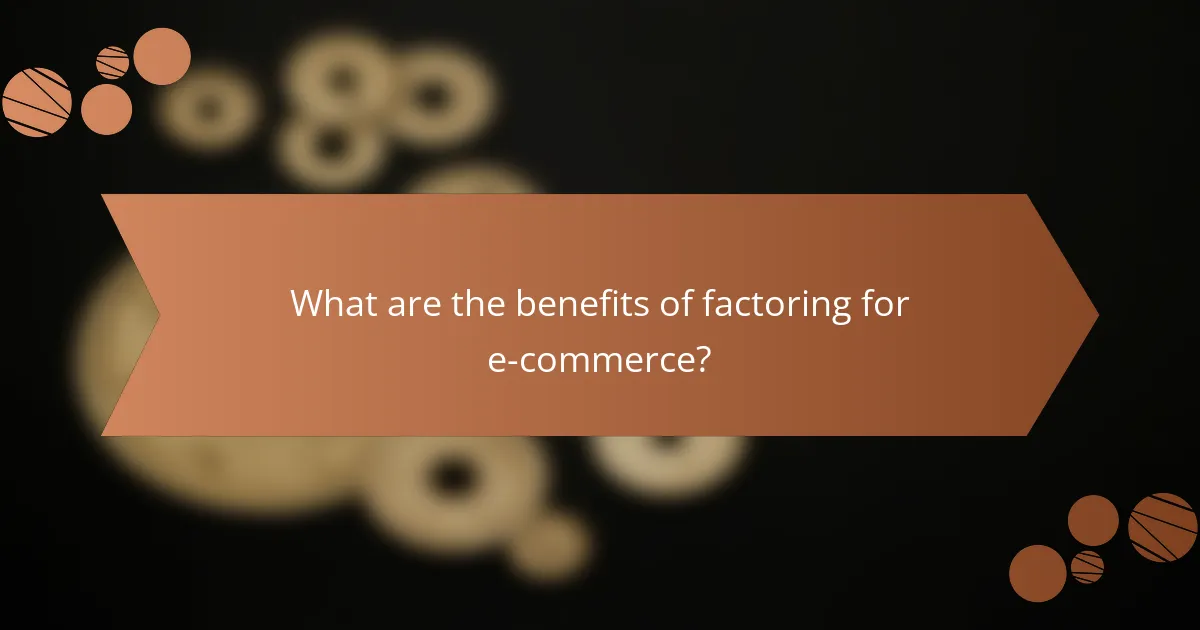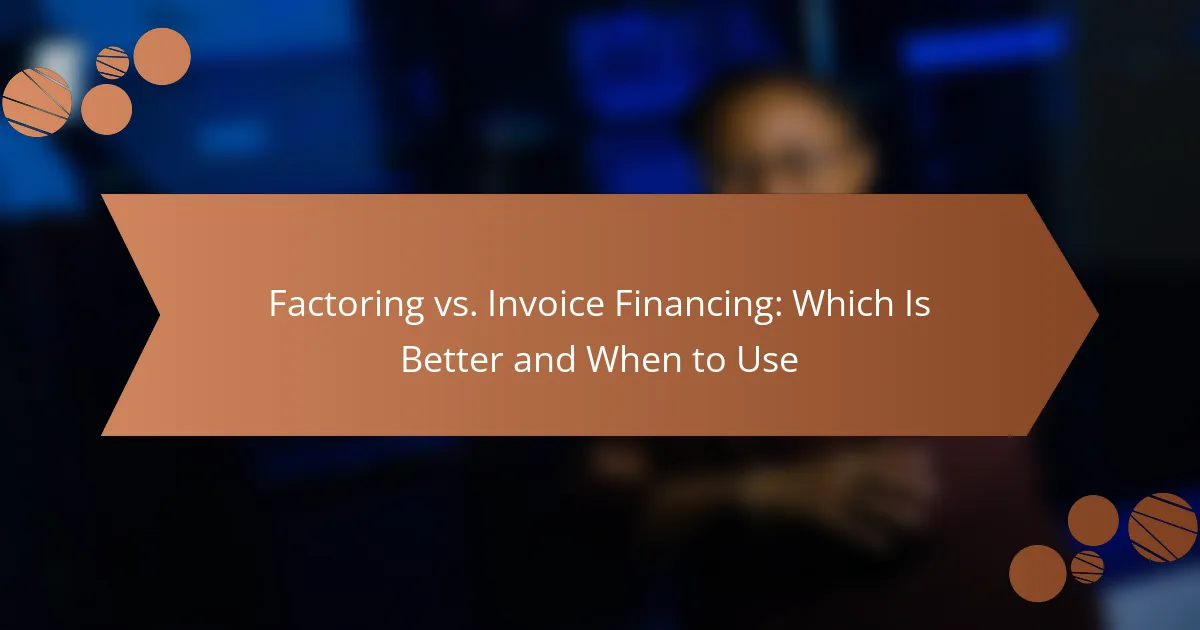Factoring and invoice financing are two effective strategies for businesses seeking to enhance cash flow by utilizing unpaid invoices, each with its unique advantages. Factoring provides immediate cash by selling invoices to a third party, making it suitable for companies needing quick liquidity. In contrast, invoice financing allows businesses to borrow against their invoices while keeping ownership, preserving customer relationships and payment terms. Understanding the differences between these options can help businesses choose the best approach based on their specific financial needs.

What are the differences between factoring and invoice financing?
Factoring and invoice financing are both methods businesses use to improve cash flow by leveraging unpaid invoices, but they operate differently. Factoring involves selling invoices to a third party for immediate cash, while invoice financing allows businesses to borrow against their unpaid invoices while retaining ownership.
Factoring involves selling invoices for immediate cash
In factoring, a business sells its invoices to a factoring company at a discount. This provides immediate cash flow, which can be crucial for covering operational expenses. Typically, businesses receive a percentage of the invoice value upfront, often around 70-90%, with the remainder paid after the customer settles the invoice.
For example, if a company has an invoice worth $10,000, it might receive $7,500 to $9,000 immediately from the factor. The factor then collects the full amount from the customer, keeping a fee for their service.
Invoice financing allows borrowing against unpaid invoices
Invoice financing enables businesses to use their unpaid invoices as collateral for a loan. Unlike factoring, the business retains ownership of the invoices and is responsible for collecting payments from customers. This method typically allows access to a percentage of the invoice value, often between 70-90%, similar to factoring.
This approach can be beneficial for businesses that want to maintain control over their customer relationships while still improving cash flow. For instance, a company with $50,000 in unpaid invoices could secure a loan of $35,000 to $45,000 against those invoices.
Factoring typically requires customer notification
When a business opts for factoring, it usually must inform its customers that their invoices have been sold to a third party. This notification is necessary because the factor will be collecting payments directly from the customers. Some businesses may find this intrusive or worry about how it might affect customer relationships.
Moreover, customers may be more cautious about paying invoices that have been factored, as they might not be familiar with the factoring company. Therefore, businesses should consider the potential impact on customer trust before choosing this option.
Invoice financing maintains customer relationships
Invoice financing allows businesses to keep their customer relationships intact since they continue to manage collections. This can lead to a more seamless experience for customers, as they are not notified of any changes in payment processing.
Maintaining these relationships can be crucial for businesses that rely on repeat customers. By using invoice financing, companies can avoid the potential disruption that might arise from factoring, ensuring that customer trust and loyalty remain strong.

When should I use factoring for my e-commerce business?
Factoring is beneficial for e-commerce businesses that need quick access to cash by selling their receivables. This financing option is ideal when immediate liquidity is necessary to maintain operations or invest in growth.
Use factoring for immediate cash flow needs
Factoring provides a fast solution for businesses facing cash flow shortages. By selling invoices to a factoring company, you can receive cash within a few days instead of waiting for customers to pay, which can take weeks or even months.
For instance, if you have invoices totaling $50,000, a factoring company might advance you 70-90% of that amount upfront. This immediate cash can help cover payroll, inventory purchases, or other urgent expenses, ensuring your business runs smoothly.
Use factoring when managing high volumes of invoices
If your e-commerce business generates a large number of invoices regularly, factoring can simplify your accounts receivable management. Instead of tracking numerous payments, you can outsource this function to a factoring company, allowing you to focus on sales and customer service.
Consider a scenario where you issue hundreds of invoices each month. Factoring can streamline your cash flow by converting these invoices into immediate funds, which can be particularly useful during peak sales seasons or when launching new products.

When is invoice financing a better option?
Invoice financing is often a better choice when businesses need immediate cash flow without disrupting customer relationships. This method allows companies to access funds tied up in unpaid invoices while maintaining their client interactions and payment terms.
Choose invoice financing for maintaining customer relationships
Invoice financing helps preserve customer relationships by allowing businesses to offer flexible payment terms. Rather than pushing for immediate payment, companies can use financing to bridge the gap between invoicing and receiving payment, ensuring clients remain satisfied.
For example, a company that provides services to clients may prefer invoice financing to avoid pressuring clients for quick payments. This approach can foster loyalty and repeat business, as clients appreciate the understanding and flexibility.
Opt for invoice financing when flexibility is required
Invoice financing offers significant flexibility, making it suitable for businesses with fluctuating cash flow needs. Companies can choose which invoices to finance, allowing them to tailor their financing strategy based on current financial demands.
For instance, a seasonal business may find invoice financing advantageous during peak periods when cash flow is tight. By financing only the invoices that are most critical, they can manage their expenses effectively without overcommitting to long-term loans.

What are the costs associated with factoring and invoice financing?
The costs associated with factoring and invoice financing can vary significantly based on the provider and the terms of the agreement. Generally, factoring involves higher fees compared to invoice financing, which typically has lower interest rates but may include additional charges.
Factoring fees are typically higher than invoice financing
Factoring fees usually range from 1% to 5% of the invoice amount, depending on the risk and the factoring company. These fees can accumulate quickly, particularly if the invoices are not paid promptly. Businesses should carefully evaluate these costs against their cash flow needs.
In contrast, invoice financing often has lower fees, primarily consisting of interest on the borrowed amount. While factoring provides immediate cash by purchasing invoices, the higher fees can make it less appealing for businesses with tight margins.
Invoice financing interest rates vary based on the lender
Interest rates for invoice financing can vary widely, typically ranging from 5% to 15% annually, depending on the lender’s policies and the borrower’s creditworthiness. Factors such as the volume of invoices and the business’s financial health can also influence these rates.
When considering invoice financing, businesses should compare offers from multiple lenders to find the most favorable terms. Understanding the total cost of borrowing, including any hidden fees, is essential for making an informed decision.

How do I choose between factoring and invoice financing?
Choosing between factoring and invoice financing depends on your cash flow needs and how you manage customer relationships. Factoring provides immediate cash by selling invoices, while invoice financing allows you to borrow against unpaid invoices, retaining control over collections.
Assess cash flow needs and urgency
Understanding your cash flow requirements is crucial when deciding between factoring and invoice financing. If you need quick access to funds, factoring is often faster, as it can provide cash within a day or two after invoice submission. In contrast, invoice financing may take longer due to the approval process.
Consider your business’s financial health and how quickly you need funds. If you face urgent expenses or payroll, factoring might be the better option. For less immediate needs, invoice financing could suffice, allowing you to maintain customer relationships without selling invoices outright.
Evaluate customer relationship management preferences
Your approach to managing customer relationships can influence your choice. Factoring involves selling invoices to a third party, which means the factor will handle collections. This can be beneficial if you prefer to focus on other aspects of your business but may affect how customers perceive your brand.
On the other hand, invoice financing allows you to retain control over collections, which can be important for maintaining strong customer relationships. If your clients value direct communication and personalized service, invoice financing may be the preferable route.

What are the risks of factoring and invoice financing?
Factoring and invoice financing both carry specific risks that businesses should consider. These include potential impacts on customer relationships and the risk of accumulating debt, which can affect financial stability.
Factoring may impact customer perception
When a business opts for factoring, it sells its invoices to a third party, which may lead customers to perceive the company as financially unstable. This perception can damage trust and long-term relationships, as clients might worry about the company’s ability to manage its finances.
Additionally, the involvement of a factoring company can result in customers receiving communications from a third party, which may confuse or frustrate them. Maintaining clear communication with clients about the factoring arrangement is essential to mitigate these concerns.
Invoice financing may lead to debt accumulation
Invoice financing allows businesses to borrow against their outstanding invoices, which can lead to a cycle of debt if not managed carefully. Companies may find themselves relying on this financing method to cover operational costs, creating a dependency that can strain cash flow.
It’s crucial for businesses to assess their cash flow needs and repayment capabilities before engaging in invoice financing. Setting limits on how much to borrow and ensuring that the financing aligns with revenue cycles can help prevent excessive debt accumulation.

What are the benefits of factoring for e-commerce?
Factoring offers e-commerce businesses a way to improve cash flow by selling their accounts receivable to a third party. This can lead to immediate funding, allowing businesses to reinvest in inventory, marketing, or operational expenses without waiting for customer payments.
Immediate access to cash flow
One of the primary benefits of factoring is the immediate access to cash flow it provides. Instead of waiting 30 to 90 days for customers to pay invoices, businesses can receive a significant portion of the invoice amount upfront, often within a few days. This quick turnaround can be crucial for e-commerce companies that need to manage inventory and fulfill orders promptly.
For example, if an e-commerce business has $50,000 in outstanding invoices, it might receive around 70-90% of that amount through factoring. This means they could access $35,000 to $45,000 almost instantly, which can be reinvested to meet demand or cover operational costs.
Improved cash flow management
Factoring can enhance cash flow management by providing predictable funding. With a consistent influx of cash from factoring, e-commerce businesses can better forecast their financial needs and avoid cash shortages. This reliability allows for more strategic planning and investment in growth opportunities.
Additionally, businesses can use factoring to smooth out cash flow fluctuations that often occur in e-commerce due to seasonal sales patterns. By having access to cash when needed, they can maintain operations without disruption.
Reduced credit risk
Factoring can also help mitigate credit risk. Since the factoring company takes on the responsibility of collecting payments from customers, e-commerce businesses can reduce their exposure to bad debts. This is particularly beneficial for companies that sell to new or less-established customers.
By working with a factoring partner that conducts credit checks on customers, businesses can make informed decisions about which invoices to factor, thereby minimizing the risk of non-payment.



